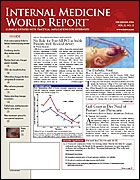Publication
Article
Internal Medicine World Report
Radioactive Seeds Precisely Localize Breast Lesions
Author(s):
PALM BEACH, Florida—Use of radioactive seed technology for breast cancer can help find and remove nonpalpable breast lesions and has been found to “decrease the number of margins that remain positive after an excision of tumors,” the technique’s developer, Charles E. Cox, MD, of the University of South Florida College of Medicine, Tampa, reported at the 10th Annual Joint Cancer Conference of the Florida Universities.
Many patients with breast cancer undergo a needle localization biopsy, in which a needle is inserted into a nonpalpable breast lesion. The site of the lesion is marked with a wire that extends outside of the breast. The procedure requires a good deal of logistic effort, and the wire must be removed the same day it is inserted.
The new technique, which eliminates the risk of infection along with the discomfort, uses a radioactive seed as a marker instead of a wire; the probe used is the same as that used to locate sentinel nodes. The seed can be inserted for up to 5 days before surgery, allowing the patient to go home and return on the day of the operation, without having to endure an additional procedure.
The radioactive seed technique, which is approved for other purposes, such as prostate cancer therapy, is not yet approved for breast cancer but is currently used on a research protocol at several cancer centers.
The seed is a small piece of silver wire (length, 4.5 mm in diameter, 0.8 mm) encapsulated in titanium that fits through a thin-walled, 18-gauge needle. Radioactive seed implantation dramatically improves the ability to pinpoint the exact location of the breast lesion, Dr Cox told IMWR. “Once the seed is placed, it won’t migrate or move with added examinations of the breast, [such as] mammography or ultrasound, so the seed can be left in place, and the patient can go back to normal daily activities without fear that the seed is going to move. Eventually, it has to be removed, along with the lesion.”
He added that “radioactive seed localization is a superior method to that of the wire localization in every study performed. Improved success at first-time resection of margins is by far its best attribute.”





